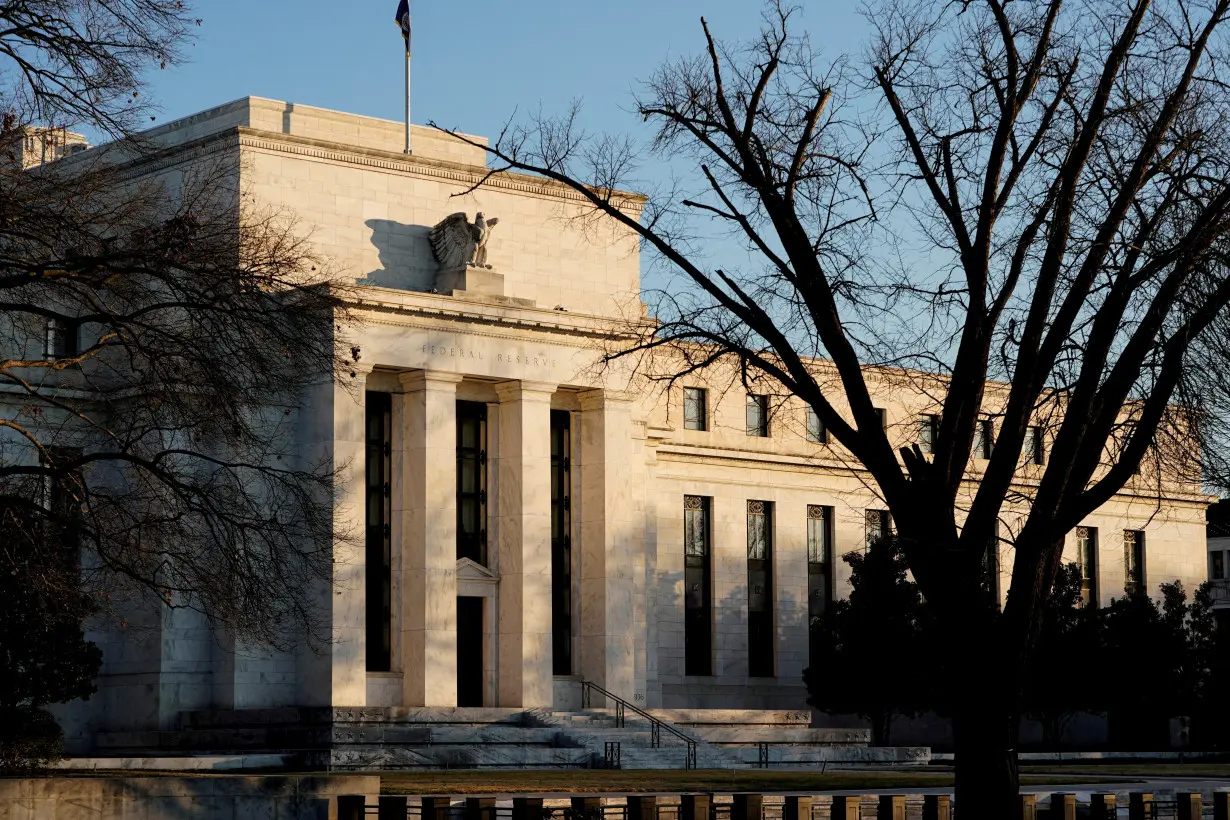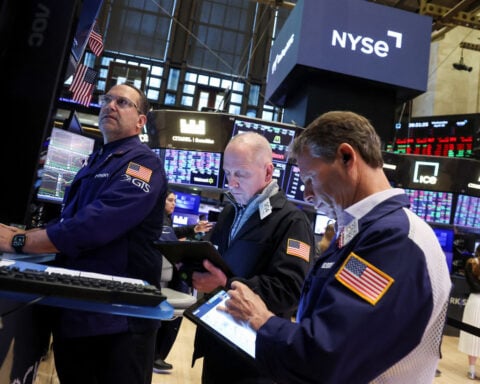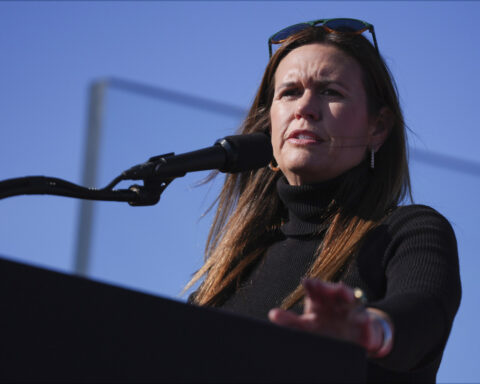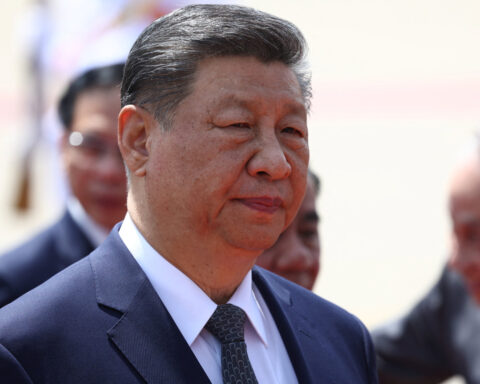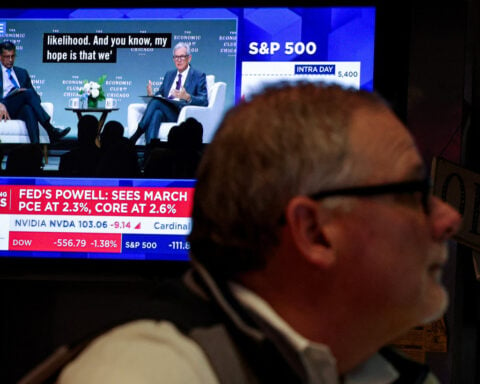By Mike Dolan
LONDON (Reuters) - If you were looking for a klaxon to mark the end of the interest rate cycle, a crushing of currency market volatility rings loudly.
Deutsche Bank's CVIX - the currency market's version of Wall St's "fear index" of stock volatility and a weighted average of implied "vol" in nine major pairings - has basically imploded.
Subdued since mid-year, the CVIX took another sharp leg lower this month and hit its lowest since mid-February 2022 - just before Russia's invasion of Ukraine and the first of the U.S. Federal Reserve's severe five-percentage-point-plus rate rise campaign that March.
The index - where the dominant weightings of 3-month implied vol in euro/dollar and dollar/yen exchange rates account for more than 50% - is now exactly half the peaks of September last year and some 1.5 points below its historic average.
On the face of it the subsidence of volatility marks the end of "King Dollar's" latest turbulent rule as Fed tightening ceases and easing speculation now lies ahead.
By driving short-term dollar cash rates and U.S. bond yields higher over the past 20 months, the Fed basically sucked cash from the wider investment world and supercharged dollar exchange rates everywhere. Now that it looks done, the buck's finally on the back foot - plumbing levels not seen since August.
In what ING strategists Chris Turner and Francesco Pesole describe as the dollar's "long goodbye" - 2024 looks set to for a persistent, trending bear market for the greenback that in itself will sap volatility as risk markets reflate on the back of central bank easing hopes.
"To speak of 'reflationary' policy right now seems criminal – but the Fed has a dual mandate, and if inflation is coming under control through 2024 it can cut rates to ameliorate the impact on the labour force," the ING team wrote, adding commodity currencies within the G10 were a favourite for 2024.
With implied volatility directionally biased, the dollar index and the CVIX are typically well correlated and both peaked in tandem in same month of September last year.
That bias is mainly due to the disruptive aspect of dollar strength - which adds to economic, trade and financial stress around the world via inflation of commodity import prices as well as pressuring dollar-denominated debts in many emerging nations.
That sensitivity, in turn, creates friction and often leading to extreme more extreme monetary policies or even open market intervention to push back - and making a sharp dollar ascent more noisy along the way.
The flipside is more serene for the same reasons in reverse.
'NORTHWEST PASSAGE'
Nowhere is that clearer than in Japan, where Fed tightening met a persistent easy money and yield capping policy at the Bank of Japan, sank the yen to 33-year lows and drew at least one bout of intervention as the government and BOJ attempted to draw line under the yen as the dollar powered through 150 yen.
But with peak Fed rates meeting trough BOJ ones - and both at least leaning in opposite directions next year, then dollar/yen is finally recoiling in earnest and the two-point premium on dollar/yen over euro/dollar implied vol is dissipating too.
For the euro and sterling, the damage of the dollar rise was ameliorated by the parallel tightening at the European Central Bank and Bank of England. And a Fed pivot is most likely to be matched or even pre-empted by them on the downside.
While three-month U.S.-Japan interest rate differentials are their widest since 2000 and still at those peaks, U.S.-German and U.S.-British equivalent rate gaps never topped 2018 highs and are both falling again.
And while a Fed rate cut is now priced into futures by June, so too is a BOE cut - and an ECB ease is baked into money markets as soon as April.
Not much wiggle room for relative currency trades then and volatility is further contained.
And of course these moves have a habit of feeding off each other, not least in how a drop in implied vol feeds carry trades to higher interest rate currencies - not only within the G10 space, but to emerging markets and beyond and reversing the Fed vacuum cleaner of the past two years.
As the ING team point out, the yen would typically suffer in that regime too as it typically acts as cheapest funding currency. But a likely BoJ policy shift cuts across that.
To be sure, the waiting game could see some stasis re-emerge. UBS Global Wealth Management's Solita Marcelli thinks this week's slide may be "overdone" while Fed thinking becomes clearer - though selling dollar rallies probably makes sense in the interim.
But the abrasive resurgence of U.S. Treasury yields through October - as a "term premium" on Treasuries resurfaced due to worries about fiscal policy stasis and rising debt levels - may well have kept the dollar higher than volatility levels would otherwise have suggested over the past two months.
And so with yields on the wane again and the term premium now slipping back into negative territory after just two months, there may be a case for dollar weakness to play catch up.
The alternative take is that the dollar's not done yet and may not give the ghost until the Spring.
Morgan Stanley thinks the DXY index could rebound up to 8% from here to some 111 before finally falling back later in 2024. The argument is that near-term direction remains foggy as rate differentials likely continue to favour the buck through the first half of the year while growth and geopolitical risks support keeping a defensive stance in dollar cash.
"Much like the Northwest Passage in winter, the pathway toward a weaker dollar this winter is narrow, cloudy, and fraught with risk," Matthew Hornbach and team told clients this weekend.
And yet if vol is anything to go by, the clear water is already in sight.
The opinions expressed here are those of the author, a columnist for Reuters
(Editing by David Evans)

 Trump has begun another trade war. Here's a timeline of how we got here
Trump has begun another trade war. Here's a timeline of how we got here
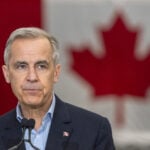 Canada's leader laments lost friendship with US in town that sheltered stranded Americans after 9/11
Canada's leader laments lost friendship with US in town that sheltered stranded Americans after 9/11
 Chinese EV giant BYD's fourth-quarter profit leaps 73%
Chinese EV giant BYD's fourth-quarter profit leaps 73%
 You're an American in another land? Prepare to talk about the why and how of Trump 2.0
You're an American in another land? Prepare to talk about the why and how of Trump 2.0
 Chalk talk: Star power, top teams and No. 5 seeds headline the women's March Madness Sweet 16
Chalk talk: Star power, top teams and No. 5 seeds headline the women's March Madness Sweet 16
 Purdue returns to Sweet 16 with 76-62 win over McNeese in March Madness
Purdue returns to Sweet 16 with 76-62 win over McNeese in March Madness
